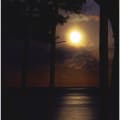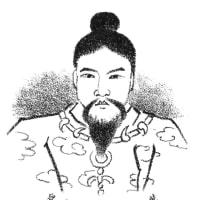『日本書紀』欽明天皇 24
冬十月、百濟聖明王更名聖王、遣西部姬氏達率怒唎斯致契等、獻釋迦佛金銅像一軀・幡蓋若干・經論若干卷。別表、讚流通禮拜功德云「是法、於諸法中最爲殊勝、難解難入、周公・孔子尚不能知。此法、能生無量無邊福德果報、乃至成辨無上菩提。譬如人懷隨意寶・逐所須用・盡依情、此妙法寶亦復然、祈願依情無所乏。且夫遠自天竺爰洎三韓、依教奉持無不尊敬。由是、百濟王・臣明、謹遣陪臣怒唎斯致契、奉傳帝國流通畿內。果佛所記我法東流。」
是日、天皇聞已、歡喜踊躍、詔使者云「朕從昔來、未曾得聞如是微妙之法。然朕不自決。」乃歷問群臣曰「西蕃獻佛、相貌端嚴。全未曾有、可禮以不。」蘇我大臣稻目宿禰奏曰「西蕃諸國一皆禮之、豐秋日本豈獨背也。」物部大連尾輿・中臣連鎌子同奏曰「我國家之王天下者、恆以天地社稷百八十神、春夏秋冬祭拜爲事。方今改拜蕃神、恐致國神之怒。」天皇曰「宜付情願人稻目宿禰試令禮拜。」
大臣跪受而忻悅。安置小墾田家、懃修出世業爲因。淨捨向原家、爲寺。於後、國行疫氣、民致夭殘、久而愈多、不能治療。物部大連尾輿・中臣連鎌子同奏曰「昔日不須臣計、致斯病死。今不遠而復、必當有慶。宜早投棄、懃求後福。」天皇曰「依奏。」有司乃以佛像、流棄難波堀江。復縱火於伽藍、燒燼更無餘。於是、天無風雲、忽炎大殿。
是歲、百濟、棄漢城與平壤。新羅、因此入居漢城。今新羅之牛頭方・尼彌方也。地名、未詳。
≪英訳≫
In the tenth month of winter, the King Seimei of Baekje (百済) changed his name to “King Seong” (聖王) and sent an envoy, the Daesol Nuri Shichikei (怒唎斯致契), a leader from the West Division of the Hime Clan (西部姫氏), to Japan. They presented a gilded bronze statue of Buddha (釋迦佛) along with banners, ceremonial canopies, and several Buddhist sutras and treatises.
Additionally, they submitted a written statement describing the merits of widely worshipping the Buddha, stating, “This teaching is the most profound among all doctrines. It is difficult to comprehend and hard to attain, so much so that even the great sages like Duke Zhou (周公) and Confucius (孔子) could not grasp it. However, it generates boundless virtues and blessings, ultimately leading to the achievement of supreme enlightenment. Just as a person holding a wish-fulfilling gem can attain whatever they desire, this precious teaching also grants all wishes. From faraway India (天竺) to the three kingdoms of Korea (三韓), people respectfully uphold and honor this teaching. Therefore, King Seimei of Baekje, with all his ministers, humbly sends his attendant Nuri Shichikei(怒唎斯致契) to bring this teaching to your imperial land, fulfilling the prophecy that ‘the Buddha’s teachings will flow eastward.’”
Upon hearing this, the Emperor was overjoyed and, summoning the envoy, said, “I have never before heard of such a profound teaching. However, I cannot make this decision alone.” He then consulted his ministers, asking, “This image of the Buddha, sent from a western kingdom, has a divine and noble appearance. Should we worship it or not?”
The Great Minister Soga no Omi Iname (蘇我大臣稻目宿禰) replied, “All the countries of the west worship it. Why should our country, Toyoashihara (豊秋日本), alone go against it?” However, Mononobe no Omuraji Okoshi (物部大連尾輿) and Nakatomi no Muraji Kamako (中臣連鎌子) argued, “Our nation has long been ruled by our great sovereigns, who have worshipped the 180 deities (百八十神) of heaven and earth, and who conduct rituals to honor them in spring, summer, autumn, and winter. Introducing the worship of a foreign god might bring the wrath of our native deities (国神).”
In response, the Emperor said, “Let it be entrusted to the willing—Soga no Iname may try worshipping it.” With this, Minister Soga received the Buddha statue with reverence and joy. He enshrined it at his residence in Oharida (小墾田) and diligently pursued Buddhist practices, later consecrating his residence at Mukuhara (向原) as a temple.
However, soon afterward, an epidemic spread throughout the country, causing many to fall ill and die. Unable to find a remedy, Mononobe no Omuraji Okoshi and Nakatomi no Muraji Kamako jointly appealed, saying, “The calamity now upon us is surely due to ignoring our counsel and bringing this worship into the land. If we return to our ways, surely fortune will follow. We should discard the Buddha and seek blessings elsewhere.” The Emperor responded, “Do as you say.”
Accordingly, the officials cast the Buddha statue into the Naniwa canal (難波堀江) and set the temple ablaze, burning it entirely. Shortly thereafter, a fire erupted in the great palace hall, even though the skies were calm with neither wind nor clouds.
In this same year, the Baekje kingdom abandoned the cities of Hansong (漢城) and Pyongyang (平壤). In their place, Silla (新羅) took control of Hansong, an area now known as Gozuhou (牛頭方) and Nimihou (尼彌方) in Silla territory. The exact location of these names remains unclear.
≪この英文の和訳≫
冬十月、百済(くだら)の聖明王(せいめいおう)は、名前を聖王(せいおう)と改め、西部姫氏達率(せいぶきし たつそつ)の怒唎斯致契(ぬりしちけい)らを日本に派遣した。彼らは釈迦仏(しゃかほとけ)の金銅像(かねのみかた)一体、幡蓋(はたきぬがさ)数点、経典数巻を献上した。さらに別の書状を添え、仏教を広めて礼拝する功徳について述べている。その内容は「この法(仏教の教え)は、すべての教えの中で最も優れている。理解も困難であり、周公(しゅうこう)や孔子でさえも知りえないものである。この教えは無限の福徳と果報を生み、究極の悟りを得させる力がある。例えば、人が“随意宝(ずいいほう)”と呼ばれる宝を持っており、その宝で何でも思いのままになるのと同様に、この法(教え)もまた、願いをかなえるものである。願わくば、この尊い法により不足のないように祈りたい。この教えは、遠くインドから三韓に至るまで尊重されている。百済の聖王とその臣下は、この教えを日本に伝え、広く国内に行き渡ることを願っている。仏が『我が教えは東に伝わるであろう』と予言されたことを実現させようとするものである」というものであった。
その日、天皇はこのことを聞き、歓喜して飛び上がるほど喜ばれた。そして使者に向かって、「私はこれまでこのような妙なる教えを耳にしたことがない。しかし、私ひとりで判断することはできない」と述べられた。そして、群臣に尋ねて言われた。「西の国から送られてきた仏像は、その容姿が端麗で、見たこともないものである。これを礼拝すべきであろうか、どうであろうか」と。
蘇我大臣(そがのおおおみ)稲目宿禰(いなめのすくね)は答えて言った。「西の諸国は皆この仏を礼拝している。豊かな日本だけが背を向けるのはいかがなものであろうか」。物部大連(もののべのおおむらじ)尾輿(おこし)と中臣連(なかとみのむらじ)鎌子(かまこ)は、同じく答えて申した。「我が国の天皇が天下を統治するのは、常に天地と社稷(しゃしょく)をつかさどる八百万の神(ももあまりやそがみ)を、春夏秋冬の折々に祀ることにある。今、初めて異国の神(仏)を拝めば、恐らく国の神々が怒るであろう」。
天皇は、「それでは、この仏を稲目宿禰に託し、試みに礼拝させてみよう」と述べられた。大臣はその命を受けて喜び、仏像を小墾田(おはりだ)の自邸に安置し、心を込めて仏道を修行する場とした。また、向原(むかいばら)の邸宅を清めて寺とした。
その後、国中で疫病が流行し、多くの民が若くして亡くなり、長く続いて手立てもなかった。物部大連の尾輿と中臣連の鎌子は、共に奏上して申した。「先ごろ、我々の意見を用いられなかったことで、この疫病が発生した。今、仏を捨て去れば、きっと良いことが起きるであろう。仏像を早く処分し、後の福を祈り求めるべきである」。天皇は「その意見に従うように」と命じられた。
役人は仏像を難波(なにわ)の堀江に流し捨てた。また寺に火をつけ、残らず焼き尽くした。そのとき、天には風も雲もなかったにもかかわらず、突然、宮中の大殿が炎上した。
その年、百済は漢城(かんじょう)と平壌(へいじょう)を放棄した。これを受け、新羅(しらぎ)は漢城を占拠した。現在の新羅の地名である「午頭方(ごずほう)」や「尼弥方(にみほう)」にあたるが、詳しい地名は不明である。
令和6年10月28日(月) 2024














